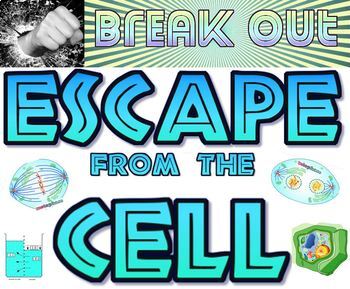Break Out: Cells, organelles, mitosis, osmosis escape room (virtual & in person)
- Zip
Description
Cells break out escape room
A life science escape room by Kathy Applebee; content area: life science, biology, cells, mitosis, organelles, osmosis.
Students must use what they know about the functions of the organelles, phases of mitosis, osmosis and the contributions of Robert Hooke and the microscope to cell theory to be successful.
Includes clues, directions, 8 exit ticket and writing prompt suggestions, reflection questions, online resources, standards in math and science and editable rubric.
Recommended Ages/ target audience: Middle and high school. ideal Group Size: classroom; suggested Time: 5 minute introduction, 50 minute playing time, additional time for reflection and exit tickets
STORY: Your paycheck arrives and you have plans to spend all of it. But when you get to the bank, they won’t cash it because your mentor and boss, Dr. Schwann forgot to sign it. He has been preoccupied lately while researching cells. Dr. Schwann has done something crazy once again and needs you to retrieve a vial of grow back solution for him. You have less than 90 minutes to do that and get to the bank to cash your check.
Materials needed for in person: 3 and 4 number combo locks, directional and letters locks, clues, 6 lock hasp
Standards
MS-LS1-1. Conduct an investigation to provide evidence that living things are made of cells; either one cell or many different numbers and types of cells. [Emphasis is on developing evidence that living things (**including Bacteria, Archaea, and Eukarya) are made of cells, distinguishing between living and non-living things, and understanding that living things may be made of one cell or many and varied cells.
MS-LS1-2. Develop and use a model to describe the function of a cell as a whole and ways parts of cells contribute to the function. [Emphasis is on the cell functioning as a whole system and the primary role of identified parts of the cell, specifically the nucleus, chloroplasts, mitochondria, cell membrane, and cell wall.]
LS1.A: Structure and Function
All living things are made up of cells, which is the smallest unit that can be said to be alive. An organism may consist of one single cell (unicellular) or many different numbers and types of cells (multicellular). (MS-LS1-1)
Within cells, special structures are responsible for particular functions, and the cell membrane forms the boundary that controls what enters and leaves the cell. (MS-LS1-2)
Math
CCSS.MATH.CONTENT.5.G.A.1 Graph points on the coordinate plane to solve real-world and mathematical problems.
CCSS.MATH.CONTENT.6.EE.A.2
Write, read, and evaluate expressions in which letters stand for numbers.
Recommended Ages/ target audience: middle or high school
Ideal Group Size: 8 -12/ set up or groups of 3-4 for virtual
Suggested Time: 10 minutes for introduction, 40 minutes playing time, additional time for reflecting/debriefing activities
More Break outs, products and freebies
Break Out: The DNA Mystery life science
Periodic Table and atomic structure Break Out
Break Out: Infection escape room
Escape Room Break Out Rubric freebie
Break Out: Daniel and the Magi
Tower of Babel breakout freebie Escape room fun
Break out: Photosynthesis carbon cycle escape room
The Pilate Inscription breakout freebie Great for Easter
Break Out: The Assyrian Deception freebie
Break Out Force and Motion physical science
Back to School lab safety freebie
Super cell megapack Get the bundle and save big
Cell cycle card game (mitosis)
Cell organelle & process card game





